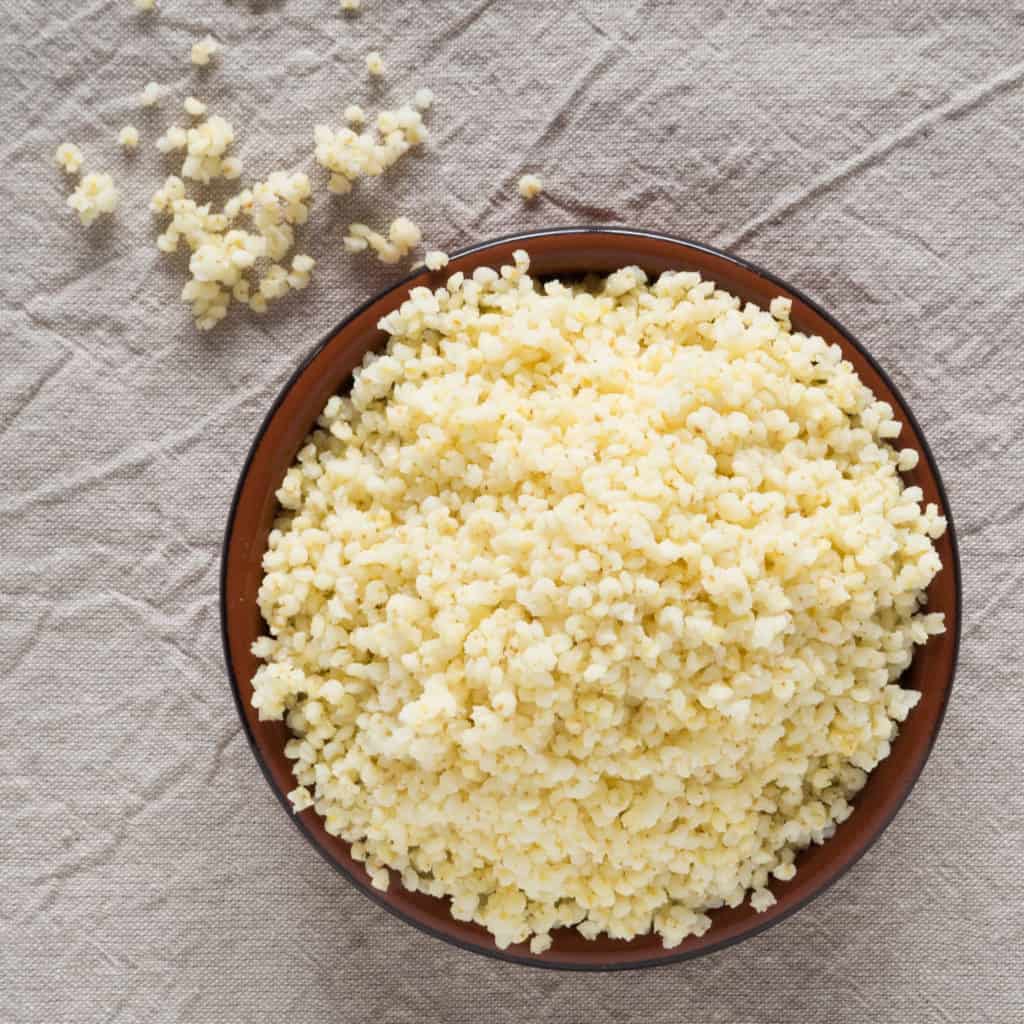
Millet is a much underrated and underused grain. Often thought of as budgie food in the UK, it is the staple food of around half of the population of the world. Originating in Africa and China it is a small grain rich in B vitamins and manganese and very versatile. I love it because it is so easy to cook but it also puffs up like tiny, little, popcorn. This makes it a wonderful side to soak up rich sauces or as a salad to soak up dressings.
Find the full Basics – Perfect Millet recipe here.
Naturally gluten-free, millet is a wonderful grain that can be used as an accompaniment to almost any dish from curry e.g. Chick Peas and Kale in Tamarind Tomato Sauce to Chilli Sin Carne and in salads. This method produces a light and fluffly grain (a cross between cous-cous, popcorn and quinoa) but millet can also be cooked with more water to produce a wet-polenta or porridge like side.
This method to cook millet works every time! The key to this Perfect Millet method is toasting the millet before cooking. Super easy. I cook my Perfect Millet in a pan on the hob using one of the many absorption methods – where the grain is cooked with only the volume of water required to cook the grain. As the method suggests the water is absorbed by the millet. There are lots of other absorption methods – this is the tastiest and most consistent. Other methods include steaming, boiling in excess water, in the microwave, in a rice cooker and so on…
This is one of the rare occasions that ingredients are measured by volume rather than weight. I estimate as a guide that 200 millilitres of dry millet will serve approximately four to six people.
I do not add salt. I do not think millet needs salt. However for an extra dimension you can use gluten free, vegan stock instead of boiling water in the recipe below.
Preparation
Difficulty easy
Preparation time 0 minutes
Cooking time 25 minutes (including standing time)
Allergens
Millet is gluten-free, vegan as well as…
Celery free
Coconut free
Garlic free
Lupin free
Mustard free
Nightshade free
Onion free
Peanut free
Sesame free
Soya free
Tree nut free.
About
Millets are a group of highly variable small-seeded grasses, widely grown around the world as cereal crops or grains for animal feed and human food. Millets are important crops in the semiarid tropics of Asia and Africa (especially in India, Mali, Nigeria, and Niger) – 97% of millet production occurs in developing countries. The crop is popular because of its productivity and short growing season under dry, high-temperature conditions. Millets are highly tolerant of extreme weather conditions such as drought and are nutritious compared to the major cereals such as rice and wheat. They contain low phytic acid and are rich in dietary fibre, iron, calcium, and B vitamins.
The most widely grown millet is pearl millet – an important crop in India and parts of Africa. Finger millet, proso millet, and foxtail millet are also important crop species.
Consumption of the minor millets goes back to the beginning of the ancient civilisations of the world. Millets are major food sources in arid and semiarid regions of the world, and feature in the traditional cuisine of many others. In western India, sorghum has been commonly used with millet flour for hundreds of years to make the local staple, hand-rolled flat bread (rotla in Gujarati, bhakri in Marathi, or roti in other languages).
Millet porridge is a traditional meal in Russian, German, and Chinese сuisines. In Russia, it is eaten sweet (with milk and sugar added at the end of the cooking process) or savoury with meat or vegetable stews. In China, it is eaten without milk or sugar, frequently with beans, sweet potato, and/or various types of squash. In Germany, millets are eaten sweet, boiled in water with apples added during the boiling process and honey added during the cooling process.
Per capita consumption of millets is the highest in Western Africa. Millets are estimated to account for about 35% of total cereal food consumption in Burkina Faso, Chad and the Gambia. In Mali and Senegal, millets constitute roughly 40 percent of total cereal food consumption per capita, while in Niger and arid Namibia it is over 65%. Other countries in Africa where millets are a significant food source include Ethiopia, Nigeria and Uganda. Millet is also an important food item for the population living in the drier parts of many other countries, especially in eastern and central Africa, and in the northern coastal countries of western Africa. In developing countries outside Africa, millet has local significance as a food in parts of some countries, such as China, India, Burma and North Korea.
The use of millets as food fell between the 1970s and the 2000s, both in urban and rural areas, as developing countries such as India have experienced rapid economic growth and witnessed a significant increase in per capita consumption of other cereals.
Millet is so much more than budgie food!